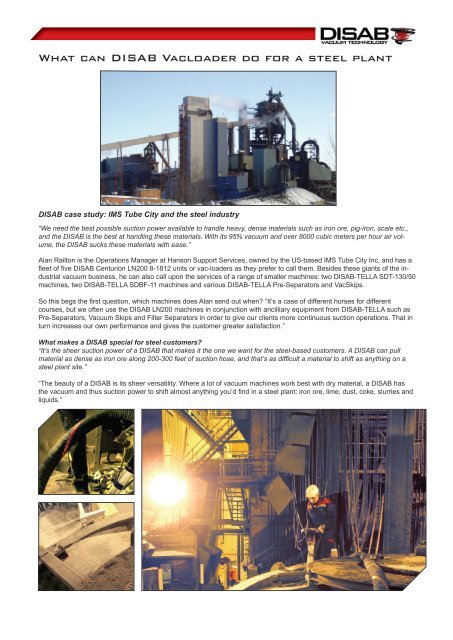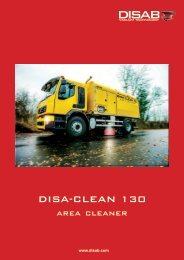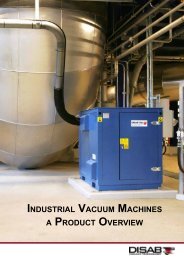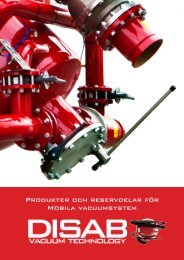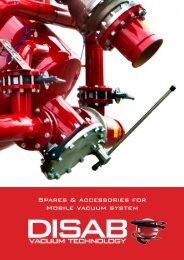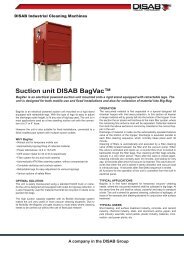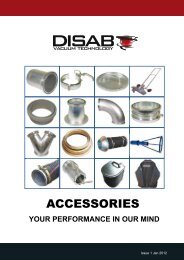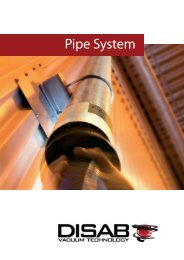Case Story2 - Disab.com
Case Story2 - Disab.com
Case Story2 - Disab.com
Create successful ePaper yourself
Turn your PDF publications into a flip-book with our unique Google optimized e-Paper software.
What can DISAB Vacloader do for a steel plant<br />
DISAB case study: IMS Tube City and the steel industry<br />
“We need the best possible suction power available to handle heavy, dense materials such as iron ore, pig-iron, scale etc.,<br />
and the DISAB is the best at handling these materials. With its 95% vacuum and over 8000 cubic meters per hour air volume,<br />
the DISAB sucks these materials with ease.”<br />
Alan Railton is the Operations Manager at Hanson Support Services, owned by the US-based IMS Tube City Inc, and has a<br />
fleet of five DISAB Centurion LN200 8-1812 units or vac-loaders as they prefer to call them. Besides these giants of the industrial<br />
vacuum business, he can also call upon the services of a range of smaller machines: two DISAB-TELLA SDT-130/50<br />
machines, two DISAB-TELLA SDBF-11 machines and various DISAB-TELLA Pre-Separators and VacSkips.<br />
So this begs the first question, which machines does Alan send out when? “It’s a case of different horses for different<br />
courses, but we often use the DISAB LN200 machines in conjunction with ancilliary equipment from DISAB-TELLA such as<br />
Pre-Separators, Vacuum Skips and Filter Separators in order to give our clients more continuous suction operations. That in<br />
turn increases our own performance and gives the customer greater satisfaction.”<br />
What makes a DISAB special for steel customers?<br />
“It’s the sheer suction power of a DISAB that makes it the one we want for the steel-based customers. A DISAB can pull<br />
material as dense as iron ore along 200-300 feet of suction hose, and that’s as difficult a material to shift as anything on a<br />
steel plant site.”<br />
“The beauty of a DISAB is its sheer versatility. Where a lot of vacuum machines work best with dry material, a DISAB has<br />
the vacuum and thus suction power to shift almost anything you’d find in a steel plant: iron ore, lime, dust, coke, slurries and<br />
liquids.”
“In our business, we talk about ‘offsetting charges’, ie. the relatively low charges for the hire of an operator and a DISAB<br />
against the cost of for example using a facility on site like a clarifier, or recycling tonnes of scale at a time, or clearing up spillages<br />
of valuable chemicals. One DISAB can collect up to 12 tonnes of scale for recycling where the end value is now very<br />
significant. It’s the same with coke; a DISAB can collect 10 cubic metres at a time, and four or five loads is a lot of money in<br />
material terms.”<br />
“By <strong>com</strong>parison, we can <strong>com</strong>e along with a DISAB, suck up all the hazardous dust, waste material or spillage with a fully<br />
enclosed vacuum system, and then via the Hi Lift, gravity feed all that material back out into sealed bags or containers,<br />
safely and quickly.”<br />
A typical steel plant job: cleaning out clarifiers<br />
A typical job on site at a steel plant is cleaning out clarifiers, but Tube City also clears up around conveyors and spillages of<br />
scale or iron ore: “We’ll <strong>com</strong>e and survey, and as we have all the required HSE paperwork, we can produce the risk assessment<br />
forms as well. We’ll work out where to park up the DISAB safely, what length of flexible hoses to use where, and then<br />
how best to dispose of the collected material into eg. stock yards for recycling, or blow back into silos, etc.”<br />
“We are constantly dealing with the clarifiers, a key part of any steel plant. All the processed water has to go somewhere,<br />
and that means a clarifier or a settling pond where the solids can sink to the bottom. When they’re full, we’ll <strong>com</strong>e along<br />
with one of our DISABs and suck it all out, then blow it back into another separate system or settling pond. Water is a major<br />
cost in the operation of a steel plant, so it pays to be able to re-use all the water that can be re-processed. Very little of the<br />
material we vacuum goes to landfill now. Recycling is a massive part of the modern steel industry, as it reduces the outlay<br />
for raw materials.”<br />
How does a DISAB <strong>com</strong>pare to other industrial vacuum machines?<br />
“We’ve used all sorts of similar machines, and nothing touches the DISABs. There are so many virtues to them. They’re easy<br />
and very safe to use, and the training and back up is excellent. Things like noise levels may not seem important until you<br />
stand next to a rival machine and realise you can’t hear what the operator’s saying! A DISAB operates at around 75dBA, so<br />
two operators can hear each other fairly easily, and the machine itself isn’t breaking any on-site noise levels that may have<br />
to be <strong>com</strong>plied with.”<br />
“A DISAB’s vacuum pump runs off a donkey engine, which is a major advantage. That engine can run independently using<br />
red diesel which reduces the operational cost significantly <strong>com</strong>pared to running the vacuum pump off the main engine.”<br />
“The DISAB’s suction power is in a different league, and even <strong>com</strong>pared to a dedicated vac-tanker, the DISAB can still do<br />
things a vac-tanker can’t. For example, removing oil from the surfaces of clarifiers with a vac-tanker means the suction pipe<br />
has to submerged and thus take up a huge amount of water with the oil. With a DISAB the operator can use the pipe semisubmerged<br />
and skim off all the surface oil, while minimising the<br />
amount of water intake. That’s much more efficient.”<br />
Bentleys and Minis<br />
“When it <strong>com</strong>es to essential things like capacity and air flow, <strong>com</strong>paring<br />
a DISAB with anything else is like <strong>com</strong>paring a Bentley to a<br />
Mini. Hiring the DISAB is usually a better bet, especially on a steel<br />
plant where there are iron ore pellets involved. A DISAB with 150<br />
feet of flexible suction pipe can do a much better job of removing<br />
even this kind of material safely and efficiently.”<br />
“A DISAB can also shift dry, semi-liquid, slurries and liquid material.<br />
Most vacuum suction systems can cope with dry material,<br />
but are far less efficient when it <strong>com</strong>es to slurry or liquids. When<br />
you’re on site it’s not unusual to find that what you thought was solid can turn into slurry further down, so it’s reassuring for<br />
a customer to know that we can cope with pretty well whatever we find.”<br />
Top service and support means minimal downtime<br />
“Besides all that, we like the service and support we get from DISAB itself. Since the opening of the new DISAB Service<br />
Centre in Manchester in 2008, we have used the facility a lot and we’ve found the Customer Support is always ready and<br />
willing to help whenever we need it. That means we can always be sure of getting parts when we need them, and minimise<br />
any downtime, on or offsite, and that in turn means we can spend more time solving all sorts of waste-related problems for<br />
our customers.”<br />
“That all adds up to a series of powerful reasons for using us, and why we run DISABs rather than anything else.”<br />
DISAB VACUUM TECHNOLOGY AB DISAB-TELLA AB DISAB UK Ltd DISAB GmbH<br />
mobile@disab.<strong>com</strong> • www.disab.<strong>com</strong> industrial@disab.<strong>com</strong> • www.disab.<strong>com</strong> infouk@disab.<strong>com</strong> • www.disab.<strong>com</strong> klaus.klein@disab.<strong>com</strong> • www.disab.<strong>com</strong>


